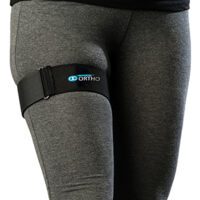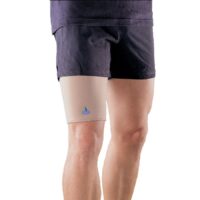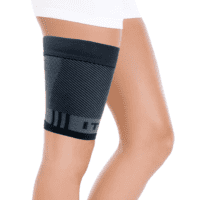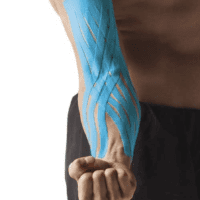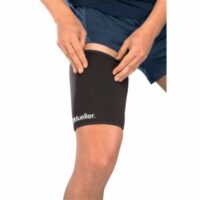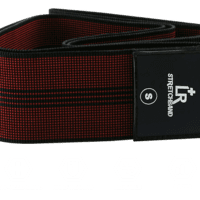Thigh Pain
Article by John Miller


Thigh Injury
What Causes a Thigh Injury?
The leading cause of thigh pain is local muscle or tendon injury. The major muscle groups of the thigh include your quadriceps, hamstrings, adductors (groin) and ITB.
Hip joint conditions such as hip arthritis can refer to your front or inner thigh. Likewise, groin injuries and pelvic disorders can also refer to this region.
Thigh pain can occur as a result of sports injuries, work injuries or simply everyday leg use.
Referred Thigh Pain
Alternatively, leg pain can be referred to by your lower back joints and nerves.
Sciatica is a well-known source of referred posterior leg pain. Your femoral nerve can refer to the front of your thigh. Both of these nerves can be irritated or pinched by lower back pathologies. A condition known as meralgia paraesthetica can affect the outside of your thigh.
Accurate Diagnosis
Based on the multitude of conditions that can cause thigh pain, an accurate professional diagnosis is vital to correct your thigh pain. After all, it is pointless treating pain originating from a referred source as a local muscle injury.
Thigh Pain Treatment & Prognosis
Most thigh pain and injury respond favourably to physiotherapy intervention when early accurate diagnosis and the appropriate treatment is sought. On the counter-side to this favourable prognosis, a poorly treated or misdiagnosed source of your thigh pain may not improve. Please consult with your trusted healthcare practitioner for a thorough assessment of your thigh pain sooner rather than later for an optimal outcome.
Common Thigh Pain Treatments
With accurate assessment and early treatment, most thigh injuries respond extremely quickly to physiotherapy allowing you to resume pain-free and normal activities of daily living quickly.
Please ask your physiotherapist for their professional treatment advice.
Related Articles
- Thigh Strain: Readers can learn about the causes, symptoms, and treatment of thigh strains, which directly relate to the SEO keywords “Thigh Injury” and “Muscle Strain”.
- Corked Thigh: This page discusses symptoms and treatment for a corked thigh, aligning with the “Corked Thigh” keyword and offering insight into a common thigh injury.
- Proximal Hamstring Tendinopathy: Offers details on diagnosis and management of high hamstring tendinopathy, relevant to the “Hamstring Strain” keyword.
- Muscle Pain & Injury: Provides a broader context on muscle pain and injuries, including those affecting the thigh, underlining the general topic of “Thigh Pain”.
- Running Injuries: Since thigh pain can be common in runners, this article gives a wider perspective on how to prevent and treat running-related thigh injuries.
- Hip Adductor Tendinopathy: Explains injuries to the muscles on the inner thigh, pertinent to “Groin Strain” and “Adductor-related Groin Pain”.
- Piriformis Syndrome: Although not directly related to thigh pain, it offers insights on sciatic pain, which can affect the thigh area, connecting to “Sciatica”.
- Greater Trochanteric Pain Syndrome (GTPS): Discusses symptoms that may extend to the lateral thigh, linking back to “Thigh Pain” and indirectly to “Meralgia Paraesthetica”.
- Gluteal Tendinopathy: Covers symptoms and treatments for tendinopathy, which can cause pain in the upper thigh area, thus indirectly related to “Thigh Injury”.
Article by John Miller
Thigh Injuries
Thigh injuries can significantly impact your daily life and activities, whether you're an athlete or someone who enjoys staying active. As a physiotherapist, I often encounter individuals seeking assistance for various lower body ailments. In this guide, I'll discuss the most common thigh injuries, their causes, prevention strategies, and when to seek professional advice.


Common Thigh Injuries
- Thigh injuries encompass a range of conditions, including muscle strains and contusions. These injuries often occur during sports activities, sudden movements, or accidents. Symptoms may include pain, swelling, bruising, and difficulty moving the affected leg.
- A hamstring strain involves damage to one or more of the muscles at the back of the thigh. This injury is prevalent among athletes, particularly those involved in sports requiring sprinting, jumping, or sudden changes in direction. Symptoms include sharp pain, tenderness, and weakness in the hamstring muscles.
- Iliotibial band syndrome, or ITB syndrome, is a common overuse injury among runners and cyclists. It occurs when the ITB, a thick band of tissue running along the outside of the thigh, becomes inflamed or irritated. Symptoms typically include pain on the outer side of the knee, especially during activities such as running or cycling.
- Runner's knee, also known as patellofemoral pain syndrome, is a common complaint among runners, cyclists, and individuals who engage in repetitive knee movements. It causes pain around or behind the kneecap, often exacerbated by activities such as climbing stairs, squatting, or sitting for prolonged periods.
- Sciatica refers to pain that radiates along the path of the sciatic nerve, which runs from the lower back through the hips and down each leg. It can result from various factors, including a herniated disc, spinal stenosis, or muscle tightness. Symptoms may include sharp or burning pain, numbness, tingling, and weakness in the legs.
Prevention Strategies
Preventing lower body injuries begins with understanding the risk factors and implementing proactive measures. Here are some strategies to help you safeguard your lower body health:
- Warm-up and Cool-down: Incorporate dynamic warm-up exercises before physical activity to prepare your muscles and joints for movement. Follow up with gentle stretching and cool-down exercises to aid in muscle recovery and flexibility.
- Gradual Progression: Avoid overexertion by gradually increasing the intensity, duration, and frequency of your workouts. Sudden spikes in activity level can increase the risk of injury, so listen to your body and progress at a pace that feels comfortable.
- Proper Technique: Ensure proper form and technique during exercise to minimise the risk of strain or injury. Consult with a qualified fitness instructor or physiotherapist to learn correct movement patterns and modifications tailored to your needs.
- Strength and Flexibility: Incorporate strength and flexibility exercises targeting the muscles surrounding your thighs, hips, and knees. Focus on exercises that improve stability, balance, and range of motion to support your lower body joints during physical activity.
- Rest and Recovery: Allow for adequate rest and recovery between workouts to prevent overuse injuries and promote muscle repair. Listen to your body's cues and avoid pushing through pain or fatigue, as this can lead to further injury.
Conclusion
By prioritising prevention strategies and seeking professional guidance when needed, you can minimise the risk of experiencing debilitating lower body injuries. Remember to listen to your body, respect its limits, and invest in its long-term health and functionality.
What to Do?
If you're experiencing persistent pain or discomfort in your lower body, it's essential to seek the guidance of a qualified physiotherapist. They can assess your condition, provide targeted treatment, and develop a tailored rehabilitation plan to help you recover safely and effectively.
Related Articles
- Understanding and Treating Thigh Injuries
- Preventing Hamstring Strains: Tips and Exercises
- Managing ITB Syndrome: Effective Treatment Strategies
- Runner’s Knee: Causes, Symptoms, and Treatment
- Sciatica Relief: Exercises and Therapies
- Lower Body Strengthening Exercises for Injury Prevention
- The Importance of Warm-up and Cool-down for Athletes
- Understanding Overuse Injuries in Sports
- Effective Strategies for Rest and Recovery
- When to Seek Physiotherapy for Sports Injuries





